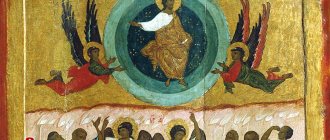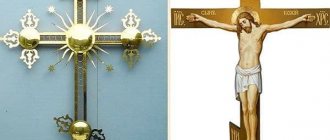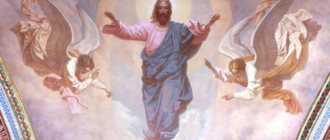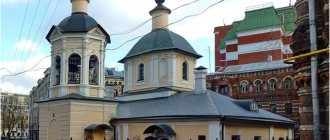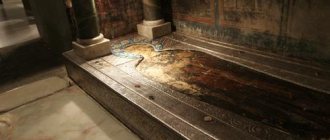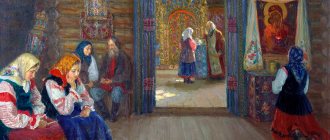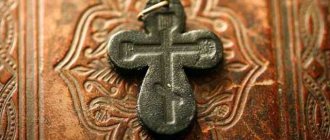An inverted cross tattoo on a person’s body is most often perceived by people as a sign that he is a Satanist. Nevertheless, such an image, although rare, is found even in Christian iconography. Which is not surprising, since over the two thousand years of the existence of Christianity, its main symbol has acquired many sizes, shapes and applications. Celtic Christians, for example, wore a pectoral cross in the form of a tattoo so as not to lose it; the T-shaped symbol was common in Egypt, and the oblique four-pointed St. Andrew's symbol was common in the Black Sea countries. In Christian culture, a Latin cross, the horizontal crossbar of which is lower than the middle of the vertical one, is called the cross of St. Peter.
What is an inverted cross, what is it called?
The inverted cross is called the cross of St. Peter, because, as Christian sources say, the Apostle Peter, the main patron of the Catholic Church, was crucified head down. They say that Peter himself chose this type of execution because he considered it unworthy for himself to die on the cross in the same way as the Teacher, Christ. This happened during the reign of Nero in 67 AD.
That is, the crossbar intended for tying the victim’s hands in an inverted cross ends up at the bottom of this execution structure.
Cross of St. Peter made of yellow and white metal.
IMPORTANT: Other names for the inverted cross are the cross with the crossbar lowered, the inverted cross, the Satanic cross, the cross of the Antichrist, the reverse crucifix.
Recommendations
- Our Christian Symbols
Friedrich Rest (ISBN 0-8298-0099-9), paragraph 29 - Sr., Stephen. Symbolism: Big Dictionary, 2nd ed.
. North Carolina: McFarland & Company. paragraph 62. Received July 20, 2022. - "The 50 Most Evil Songs of All Time." Kerrang!. Retrieved July 20, 2019.
- O'Neill, Christina. “Bill Ward: Black Sabbath's inverted cross was a publicity ploy,” Louder Sound, August 26, 2016.
- Steed, Graham. Organ works by Marcel Dupre
. Pendragon Press. paragraph 66. Received July 20, 2022.
What does an inverted cross mean as a symbol?
If the cross itself has many symbolic meanings, formed in pre-Christian times, and also established later in connection with the spread of Christianity, then the inverted cross has recently become increasingly important as a symbol of the Antichrist, Satan, and black magic. Such symbolism is supported by various media, Hollywood films and rock and punk cultures.
IMPORTANT: The Catholic Church itself does not speak unequivocally about the fact that the inverted cross is a symbol of Satan.
The inverted cross is considered one of the symbols of Satanism.
Satanic practices
The usual Latin cross for Satanists has the following meaning: the upper part is God the Father, the sides are God the Son and God the Holy Spirit. The lower part symbolizes Satan, over whom all three hypostases of God have power. What does an inverted cross give? Its meaning changes dramatically - Satan becomes higher than God, which means he can lead him.
Black magicians say that it is not customary in their practices to create new symbols. Their magic is designed to transform, not create. Therefore, the magician cannot use the same symbols that are used in white magic. He must transform these symbols in such a way as to radically change the universe.
For such purposes, an “upside down” cross is ideal, denoting the world inside out, where heaven and earth, hell and heaven have changed places.
For this reason, the cross of Peter is often found in jewelry and on clothing of people who call themselves Satanists and Goths. These subcultures oppose themselves to public opinion, and therefore to the basic tenets of generally accepted religion along with its symbols.
What does the inverted cross mean for Satanists?
But the Satanists themselves took this symbol into their arsenal.
- For them, an inverted cross is a symbol of contempt, disrespect for the dogmas of the Catholic Church and praise of the Antichrist.
- The symbolism of the upper part of a regular, non-inverted cross, where its shorter part is directed upward and to the sides, among other things, means the Trinity, the trinity of God, and the extension of his power to the surrounding world and to heaven. Satan, or the fallen Angel, is removed from God by the longer side of the cross, directed downward to the underworld. With the help of an inverted cross, Satanists exalt the object of their veneration, directing its symbol to the top and leaving the trinity of God at the bottom.
Inverted cross: meanings
In a negative sense:
- Anti-Christian Orthodox phenomena. It is perceived negatively among the Orthodox population.
- Satanism, evil spirits, demonism. The meaning is relevant for all lovers of black magic and everything connected with it.
- Complete renunciation of God, denial of the entire Christian community, protest against religion. Relevant for atheists who openly, sometimes aggressively, declare their detachment from Christianity.
In a positive sense:
- Not the only, but recognized symbol of the Catholic Church. The symbolism can be seen on the throne of the Pope. Catholics themselves claim that the symbol does not bring evil.
- Symbol of the hammer of the god Thor in Scandinavian mythology;
- Attribute of the god Apollo.
- An attribute of knights who perceive the inverted cross as a sword.
- "Female" symbol. There is no clear definition, except that it is a cross for girls.
As you can see from the list, not everything is so simple. It is noteworthy that the original meaning of the symbol was always either positive, or combative and motivating, but in no way devilish and anti-Christian, because Christianity itself had not yet existed. Scandinavian history begins about five centuries before the birth of Christ.
This suggests that no one specifically turned the cross upside down in order to summon the forces of darkness or pursue similar goals. But there is another interesting fact! The fact is that neither Jesus nor his direct followers revered the symbol or mentioned it. They didn't need symbolism at all. This, of course, does not mean that wearing a cross has no meaning. If you believe in his power, then it will act, because this is what religion is based on - on faith.
What does a tattoo mean - an inverted cross on the face, forehead, arm?
But in tattoos, the symbolic meaning of an inverted cross does not have to be associated with Satan or Satanism, since in youth tattoo culture it can be completely different.
For example:
- An inverted cross on a tattoo can have the same meaning as the symbol of a knight's sword and be associated with the traditions of chivalry.
- Means the Lorran Cross. According to legend, Joan of Arc, who came from the Lorran lands, had such a cross.
- An image in the form of an inverted cross on a tattoo can be a symbol of femininity, femininity, given the sketchy nature of the female figure in contrast to the male figure, which can be just as schematically depicted as an ordinary cross.
- Also in youth subcultures, an inverted cross can be associated with the Apostle Peter.
Inverted cross tattoo.
Everyone who decides to have a tattoo on their body in the form of an inverted cross and its various modifications puts their own specific symbolic meaning. It is safe to say that in tattoos the inverted cross and the interpretations of its symbolic meanings can be numerous and varied.
Links[edit]
- Blaney, Peter W. M. (1990). Bookshops at Paul's Cross Cemetery
. Bibliographical Society. ISBN 9780948170065. - Blaney, Peter. "The Bookshop That Never Was," in Lena Cowan Orlin (ed.), Material London, ca. 1600 (Philadelphia, 2000), p. 325."
- Wabuda, Susan (2002). Preaching during the English Reformation
. New York: Cambridge University Press. pp. 41–3. ISBN 9780521453950. - John Foxe (1887 reprint), The Book of Martyrs
, Frederick Warne and Company, London and New York, pp. 160–61 - Morrissey, Mary (2011). Politics and Paul's Sermons on the Cross, 1558–1642
. Oxford University Press. pp. 26–34. ISBN 9780199571765. - Earle, John (1628). Mycocosmography
. London. - Kirby, Torrance; Stanwood, Paul; King, John; Morrissey, Mary (2017). Sermons on Paul's Cross, 1521–1642
. Oxford University Press. ISBN 9780198723615. - History of St. Paul's Cathedral (1658), p. 134
- Morrissey, The Politics and Sermons of Paul's Cross, 1558–164 2, p. 34.
- Ward-Jackson, Philip (2003). Public sculpture of the City of London
. British public sculpture. Liverpool: Liverpool University Press. pp. 384–6. - Historic England. "St. Paul's Cross (1194637)". England's National Heritage List
. Retrieved October 25, 2014.
Inverted cross - emoticon: what does it mean?
Recently, users of all kinds of advanced devices - tablets, iPhones, iPads, etc., when communicating, are trying to diversify their messages by adding various icons and emoticons to them. Manufacturers took care of this and offered numerous emoticons in the form of emoticons, symbols, figures, and so on. Among these you can find an inverted smiley face.
And if the interpretation, for example, of an emoticon with a smile, with a tear or with a heart is quite clear and obvious, then what, in this case, can an inverted emoticon mean?
Upside down smiley.
Let's just say that today there is no unambiguous interpretation of the inverted emoticon. Many people use it to denote stupidity, thoughtless and clueless behavior.
The most famous sign of Lucifer as Satan
The main mark of Lucifer is not an inverted star, and not the number 666, as many believe. The true seal of the Ruler of Hell is a complex symbol consisting of several complex elements:
- the base of the sign is the Latin V, symbolizing both the planet Venus, Venus, which gave the name to the Devil, and the victory of “victoria” in Latin;
- above the letter rises the image of an inverted triangle, branching from the tip into figured horns, the horns intersect the fork V - a symbol of the strength of the feminine principle and masculine energy;
- from the corners of the base of the triangle descend two intersecting median-like lines - a sign of the power of the male mind and beginning.
This simple design is called the sigil of Satan and is the most powerful tool of protection against persecutors or the all-opening key to any other gate. Possession of it subjugates the will of higher demons who help Satan, reveals the dark power of the universe and expands all the secret boundaries of witchcraft.
The Sigil of Satan has been known since the early days of Christianity. It is not surprising that his occult image is repeated by many coats of arms of Rome and the Masonic Lodge. In order not to confuse them, it is better to compare different artifacts with photos.
Is it possible to draw, embroider, wear an inverted cross: a T-shirt, a pendant, a tattoo?
An image of an inverted cross in any form, such as embroidered or as a print on clothing, like a tattoo or a pendant on the neck. Often, among young people who emphasize their belonging to a certain subculture and pose a certain challenge to traditional society, you can see an image of an inverted cross in the form of:
- embroidery
- print on clothes
- tattoo
- pendant, other
This is how a person seems to declare that he is not afraid of either the devil or the devil.
Inverted cross pendant.
It is unlikely that an adult, even an adherent of Satanism, will wear this kind of symbols on the street.
Although, it must be said, there are brave souls who do not depend on public opinion and are not afraid of God's punishment. They boldly walk with the symbolism of an inverted cross, remaining original and independent. After all, it is just an image, not a creed.
We also note that if designers who define fashion choose an inverted cross for their products, this symbol may well become leading and popular among fashion followers. This happened recently when the image of a skull and crossbones became trendy. It’s quite nice, and it’s unlikely that any of those who purchased products with similar images thought about the symbolism of death in them.
Print with an inverted cross on clothing.
Use in Christianity
The official Catholic Church recognizes the inverted cross as one of its symbols. Proof of this is his image on the throne of the Pope. At the same time, this fact causes ambiguous judgments in society.
Let's try to figure out what an inverted cross means for a Christian. The main task of a person on earth is to live a life in torment in order to find eternal bliss and peace. An ordinary Latin cross symbolizes the victory of life over death, good over evil, bliss over torment. The cross of Peter, in turn, signifies the impossibility of an ordinary person to repeat the feat of Christ. Therefore, he cannot be crucified on the cross. This means that all that remains for him is the humble expectation of eternal life, which symbolizes the cross upside down.
Oddly enough, most Christians have forgotten about this meaning and consider the cross of Peter to be a satanic sign, equal in power to the pentagram. Although a few centuries ago it was he who was the sign of the crusaders of the Knights Templar, who fought for the true faith against infidel pagans.
Damage - an inverted red cross is painted on the door: what to do?
If someone finds an inverted cross painted on their door, and even in red paint, there is no need to sound the alarm and assume that damage has been caused. It’s quite possible that someone was acting up or just wanted to scare the owners.
What is recommended to do in this case? Look carefully at what paint the image was made with.
If these are ordinary acrylic or oil paints, simply wash them off the door while reciting the Lord's Prayer. After the paint is washed off, sprinkle the door with holy water.
If it is paint mixed with wax, or the blood of an animal, then it is best to carry out some ritual to protect yourself. How?
- Go to the church and buy candles there.
- Try not to take change when buying candles.
- Give alms as you leave the church.
- Bless the door with burning church candles.
- Proceed to wash off the image on the door.
- Rinse the door with holy water while reciting the Lord's Prayer.
- Go into the house and take a shower. Leave your hair bare and loose.
- Walk through the apartment or house with a candle, hold the candle for a while in each corner, also reading a prayer.
- A few days later, repeat the ritual, starting with going to church.
You need to do this three times.
If you find an inverted cross on your door, take measures to protect your home from evil forces.
History[edit]
Before the 15th century[edit]
The eastern half of Cross Cemetery was controlled by the Corporation in the Middle Ages: it was the site of London's "folklore" (or general meeting of the people). [2] The earliest folk meeting known to have been held here was held by the king's magistrate John Mansell on St Paul's Day (29 June) in 1236 to announce that Henry III wanted London to be well governed and that his freedoms were protected. [ Edit
] The Archbishop of Canterbury and the king were present at the next such meeting that we know of, in 1259, at which the people of London came to swear allegiance to the latter and his heirs (albeit under duress, since the royal army held the city gates at the time). They later gathered here to swear allegiance to Henry's enemy Simon de Montfort.
Richard Walker of Worcester, a chaplain, pleaded guilty to a charge of witchcraft here around 1422, but after renouncing the practice and being tried by the Bishop of Llandaff (then John de la Zouche), he was sent to Cheapside with with your two magics. the books are opened on him, where the books were burned and he was released without any other punishment. Reginald Pecock, Bishop of St Asaph, attacked Lollardy from this cross in 1447, but himself performed public penance there in 1457 (by which time he was Bishop of Chichester) before a crowd of 20,000 people and the Archbishop of Canterbury, throwing various specimens of his own heretical writings at fire. Thomas Netter also preached against Lollardi here.
Jane Shore, mistress of King Edward IV, was brought to the cross in 1483 and stripped of "all her splendor".
15th century[edit]
Bishop Thomas Kempe rebuilt the cross in the late 15th century in grand architectural form, as an open-air wooden pulpit with space for three or four people inside, set on stone steps with a lead roof and a low surrounding wall. [3]
Outdoor Sermon at St. Paul's Cross
16th century[edit]
"Bradford Pacifying the Riot at St. Paul's Cross", from
1887 Book of Martyrs According to Fox, Mr. Bourne, a Catholic bishop and orator, nearly led his Protestant listeners into a riot, but Bradford came to his aid and calmed the crowd. [4]
For much of the sixteenth and early seventeenth centuries, sermons were preached here weekly throughout the year. Preachers were appointed by the bishops of London. For important events or during politically sensitive times, senior clergy (including deans and bishops) will be invited to preach; on less important Sundays the bishop and his chaplains turned to newly ordained preachers from Oxford and Cambridge or to local London preachers to fill the company. During the reign of Queen Elizabeth it was sometimes difficult to find preachers willing to appear at Paul's Cross. [5] However, thanks to better funding for sermon series in the Jacobean period, preaching "on the cross" became the hallmark of the ambitious young clergyman. John Earle's “brave forward man” would have been “if he had been a schoolboy...he usually entered the department before receiving his degree; ...and his next sermon will be at Pauls
Cross, and it's printed." [6] Indeed. from the 1580s onwards, sermons were increasingly printed for distribution to a wider audience; about 370 sermons of the Cross of Paul have survived to this day, more than 300 titles have survived in print. [7] Because the pulpit stood in one of the few open spaces in an increasingly crowded city, and because royal proclamations were often made here, Paul's Cross was the site of several political unrest in the early modern period. It was the speech here that sparked the vicious May Day riots against foreigners of 1517. The ultra-Lutheran Robert Barnes attacked Stephen Gardiner from it, and in 1566 Matthew Hutton, later Archbishop of York, preached here. The first sermon preached here after the accession of the Catholic Queen Mary (by Bishop Bourne) provoked a riot - a dagger was thrown at Bourne (but he missed, stuck in one of the side posts), and he had to be rushed to safety at St. Paul's School. Thus, Mary's successor Elizabeth I kept the pulpit empty for a long time after her accession to the throne in order to protect the people from rebellion. However, when it finally came to the appearance of Doctor Samson at the Cross to announce Elizabeth's religious policy, the keys to the pulpit of the Cross were lost, and when the Lord Mayor ordered the door to be broken down, it was found to be too dirty. and in poor condition for use on this occasion. However, John Jewel was appointed preacher-elect of the Cross on June 15, 1559, and on November 26 of the same year called upon all who wished to prove the Roman case from Scripture, the councils, or the fathers, during the first six hundred years after Christ.
The end of Paul's Cross[edit]
William Dugdale claimed that the pulpit cross was destroyed under the Ordinance for the Removal of Monuments of Idolatry in 1643 at the outbreak of the First English Civil War. [8] Archival evidence shows that the pulpit had already been destroyed by 1641, however, it is most likely that the pulpit was demolished in 1635, when this part of the cathedral grounds was used as a mason's yard during renovation work. at the Council. [9]
20th century[edit]
Between 1908 and 1910 a new structure was erected on the site of St. Paul's Cross using funds provided by the will of lawyer Henry Charles Richards. Richards had hoped that the medieval preacher's cross would be reconstructed, but the Dean and Chapter of St Paul's Cathedral decided that this would not be in keeping with the architectural setting as Sir Christopher Wren had rebuilt the cathedral in the 17th century. The resulting monument is an example of the Baroque revival designed by Sir Reginald Blomfield, with a statue of St Paul by Sir Bertram Mackennal standing on a Doric column of Portland stone. The cathedral authorities' use of Richards' funds caused short-lived controversy. [10] In 1972 the monument was Grade II listed. [eleven]
- Paul Sir Reginald Blomfield Cross
- Statue of St. Paul by Sir Bertram Mackennal
- Memorial plaque on the 20th century Paul's Cross in memory of his predecessor
The Star Sign as a symbol of Lucifer or Darkness
The five-pointed star, a symbol of socialism, familiar to many, is in fact the second true attribute of Evil. Many believe that this pentagram represents magic in general, being equally useful for both white and dark magicians. However, in fact, this is the true mark of the Devil, depicting the morning star, Dennitsa, after which the former leader of the angels was named.
At the same time, in a straight position, when there is only one beam at the top, it can really protect in some situations. It’s just that the resulting bill will not come entirely from God. In its inverted form, the star turns into a strengthened sign of Lucifer, capable of inflicting inhuman damage to enemies and carrying out its plans.
Most often, the Star Sign, as a symbol of the Fallen, is placed inside a circle. In its pure form, this artifact has been used by peoples since ancient times, symbolizing otherworldly power. The pentagram was used by the Sumerians, ancient Egyptians, and Babylonians; in Kabbalah it means the sacred Pentateuch. But in Christianity it has always been a symbol of an Angel, named after the morning star that brings light. And his fate is known.
Cross of Lucifer
This symbol of Lucifer has a simple sacred meaning - an inverted cross for crucifixion, as an indicator of rejection of the Son of God, the enemy of the Devil.
It does not carry any special magic, although it has been actively used since the very first days of the birth of Christianity by its irreconcilable opponents. Thus, Saint Peter was crucified on an inverted cross, as a sign of the overthrow of Christian power. It is echoed by the Roman Cross of Disorder, ending with a hook at the end. The Romans, who did not accept Christianity, thus expressed their contempt for the new religion. It is not a true sign of Lucifer, but acts as a strong energetic symbol of resistance to God.
Another inverted and broken cross, where Christ was crucified, is hidden in the most unexpected sign, which many perceive as a bright symbol of the denial of wars. This is the Cross of Nero - Pacific, chicken foot.
You can read who the cruel Nero is on Wikipedia, and the devil’s cross, enclosed in a circle, now cunningly walks around the world under the guise of pacifism.



